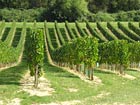Diverse Terroirs 
The Génissac terroir, which makes up most of the land of our Bordeaux wine Chateau de la Cour d'Argent, consists of a fine hillock of chalky clay which has much in common with St Emilion on the other side of the Dordogne.
The St Emilion terroir consists of a sandy gravel with very deep gravels and above all, a cool ferriferous subsoil. A parcel of land has been identified and set apart for its particularly high quality, to produce the Cuvée Lynsolence.
Other parcels are also used, each to give their particular character. Some of these, now classed as Bordeaux, were once included under the St Emilion appellation.
Varietals
planted :
In the Saint Emilion appellation:
- 100% Merlot, with vines from 35 to 50 years old.
In the Bordeaux Supérieur appellation: 35 years old vines.
- Merlot 90%, Cabernet Franc 5%, Cabernet-Sauvignon 5%.
Viticultural Methods 
All our vineyards are grassed, so as to keep the soil in good heart, and drained. The soil is rebalanced and improved using organic materials exclusively.
The Double Guyot training system ensures that the grapes aren't overcrowded. Yield is controlled by the partial removal of shoots during pruning, and by the elimination of shoots which bud low on the vine. Some vegetative height is encouraged. This lets us deleaf in June and August and thus the bunches are perfectly aired and can take advantage of the sunlight minimising the risk of disease.
Green harvesting is systematically carried out : by removing imperfect or unwanted bunches, those remaining can develop more completely.
The target of these rigorous viticultural techniques is to reach phenolic ripeness - that is to say, the complete ripeness of all the grapes. We can thus harvest grapes that are perfectly ripe and healthy.
All these measures lead to voluntarily low yields, with those from the cuvée Lynsolence being particularly so, from 19 to 25 Hl/Ha.
![]()










